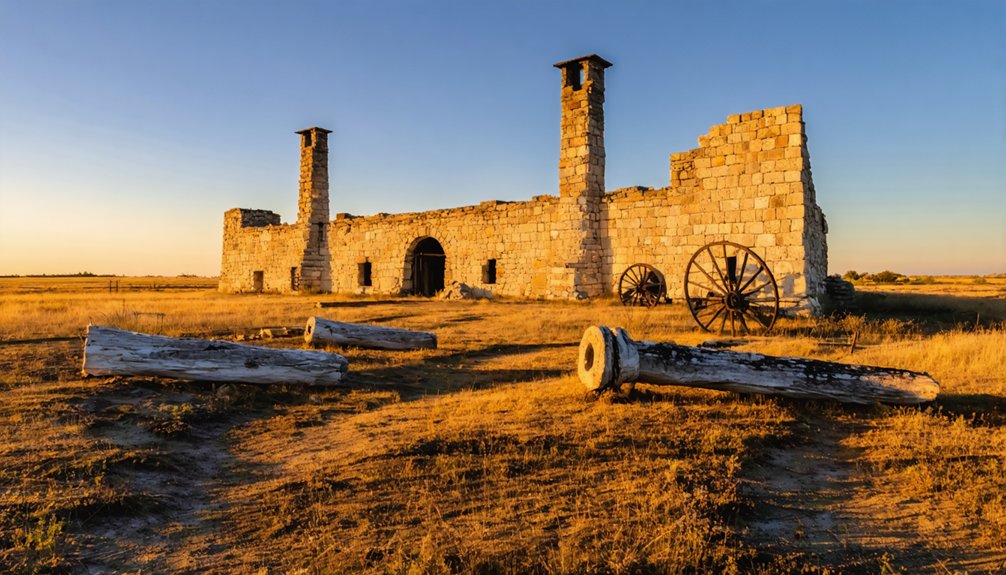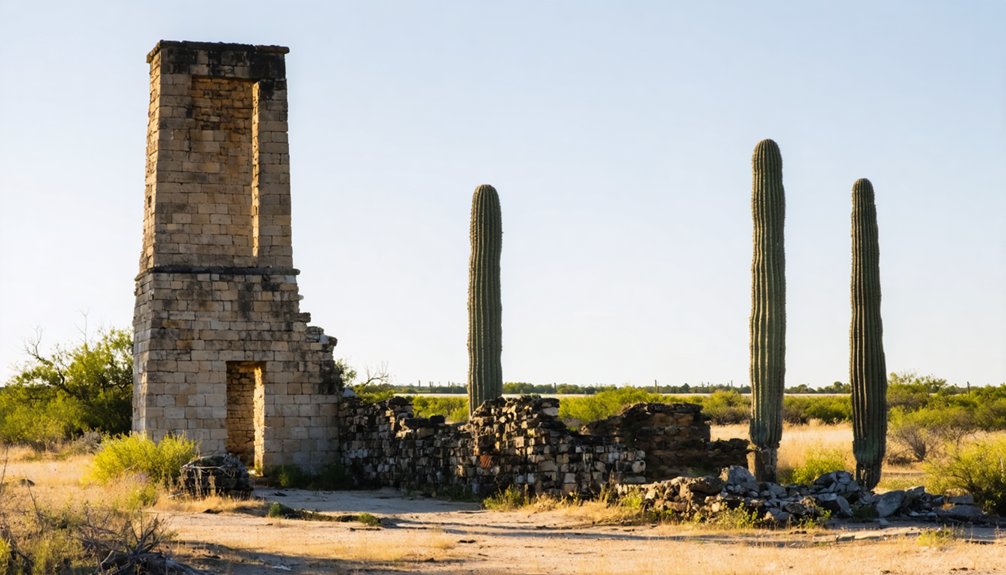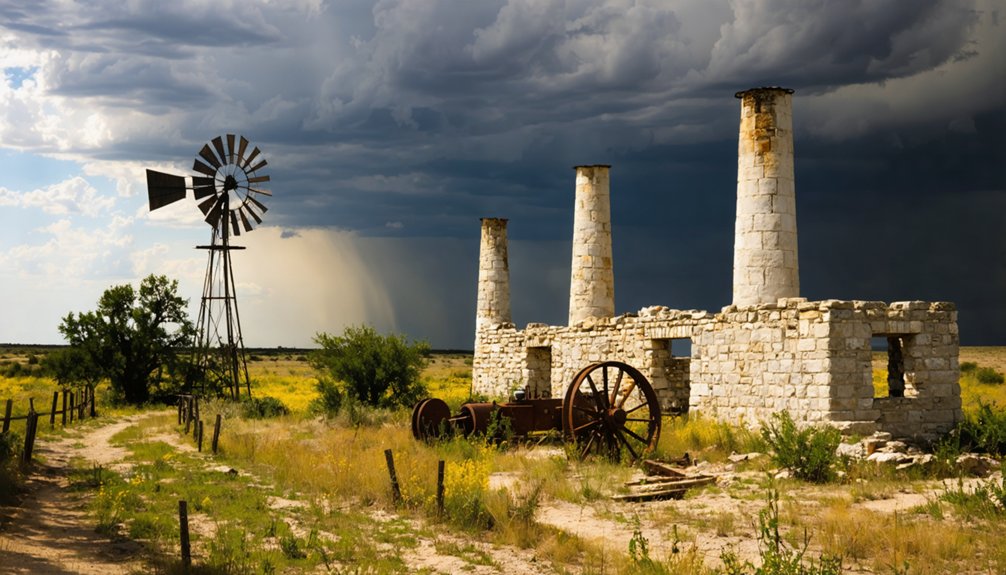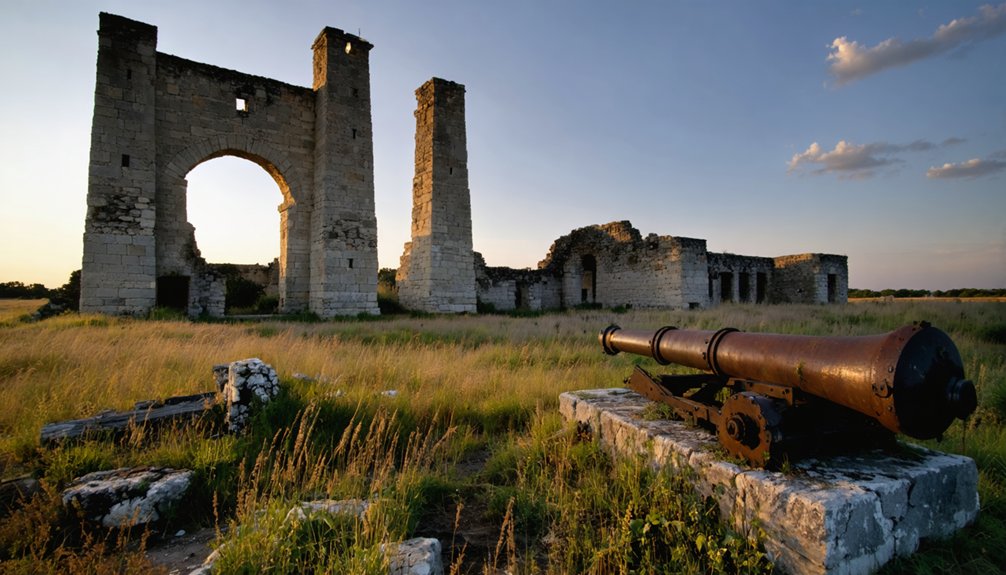You’ll discover Fort Phantom Hill‘s haunting stone ruins along Texas’s Clear Fork of the Brazos River, where five companies of the Fifth Infantry established an outpost in 1851. Though harsh conditions and supply challenges plagued the garrison, the site later flourished as a buffalo trading hub before declining when railways bypassed it. Today, three original buildings and dozens of chimneys stand sentinel, while ghostly tales of soldiers and mysterious figures persist among the weathered stones.
Key Takeaways
- Fort Phantom Hill was established in 1851 as a military outpost and later became a thriving settlement during the buffalo hide trade.
- The site features preserved ruins including three stone buildings and multiple chimneys arranged around a central parade ground.
- The settlement declined rapidly after being bypassed by the Texas and Pacific Railway, which redirected commerce to nearby Abilene.
- A devastating fire in 1854 destroyed most wooden structures following the military’s abandonment of the fort.
- The ghost town is now part of the Texas Forts Trail and is reportedly haunted by soldier apparitions and the “Lady in the Lake.”
The Origins and Establishment
As the United States sought to secure its westward expansion in 1849, the federal government commissioned Captain Randolph B. Marcy to chart exploration routes through Texas’s Comanchería. His mission aimed to protect settlers heading to California’s gold fields, leading to recommendations for a strategic line of frontier forts.
You’ll find Fort Phantom Hill‘s origins tied to this military strategy, though its location near Clear Fork of the Brazos River proved controversial. While General Persifor F. Smith redirected the fort’s placement from its initially planned Pecan Bayou site, Lt. Col. John J. Abercrombie established the post on November 14, 1851, with five companies of the Fifth Infantry. The fort’s construction faced immediate challenges due to the lack of building materials and required hauling supplies by ox wagon from up to forty miles away.
The fort became an essential part of an 800-mile defensive chain stretching across Texas, designed to shield American expansion from indigenous resistance. Under the initial command of General William G. Belknap, the fort maintained its strategic position until his illness forced him to relinquish control.
Military Life on the Texas Frontier
When you examine life at Fort Phantom Hill, you’ll find soldiers engaged in rigorous daily drills and guard rotations to maintain combat readiness on the Texas frontier.
You’ll notice how the garrison faced constant challenges with resource scarcity, particularly the limited access to water and timber, which made basic maintenance and construction tasks extraordinarily difficult. The troops had to haul building materials from a stone quarry two miles south of the fort. Under the command of Major Abercrombie, military leadership expressed serious concerns about the fort’s inhospitable location.
Despite the fort’s strategic purpose in protecting settlers from Comanche raids, you’ll see that the soldiers spent more time battling environmental hardships and isolation than engaging in actual combat with Native American tribes.
Daily Garrison Challenges
Life at Fort Phantom Hill presented soldiers with three major daily challenges that tested their resilience and resourcefulness.
First, you’d find yourself battling severe supply logistics problems, as all materials and provisions had to be hauled from distant locations. As early as November 1851, Colonel John J. Abercrombie led the initial march that established these challenging supply lines.
Second, you’d struggle with the fort’s harsh environment – a barren hilltop where you’d have to haul drinking water four miles from a spring and endure both freezing winters and scorching summers. The area’s sparsely timbered landscape made construction especially difficult.
Third, you’d face the constant strain on soldier morale due to isolation, poor nutrition, and endless construction work.
You’d spend your days quarrying stone two miles away, building fortifications, and performing garrison duties, all while coping with frequent illnesses and the psychological burden of frontier isolation.
Frontier Defense Operations
Serving as an essential link in Texas’s 800-mile defensive line, Fort Phantom Hill‘s military operations focused primarily on protecting settlers and travelers from Comanche raids across the dangerous frontier.
The Fifth Infantry companies stationed there conducted regular patrols through Comancheria territory, maintaining vigilance over migrant routes and mail stations. A brief skirmish with Indians resulted in six soldier casualties before hostilities ceased after ninety minutes of combat.
While you won’t find records of major battles at the fort, its strategic presence helped secure the region for westward expansion.
Fort operations included monitoring Native American movements and guarding the critical Butterfield Overland Mail route.
Even after the main garrison’s departure in 1854, smaller detachments continued defending the area, with soldiers like Captain Theodore Schwan’s company protecting mail stations in 1871 during the tumultuous Red River War period.
Under the command of Lieutenant Colonel Abercrombie, the fort maintained its defensive duties despite challenging conditions and limited resources.
The fort’s defensive role proved fundamental in maintaining America’s growing presence on the Texas frontier.
Legends Behind the Phantom Name
The eerie name “Fort Phantom Hill” emerged from a tense encounter in the early 1850s, when a nervous sentry fired his weapon at what he believed was a ghostly Native American figure near the fort’s perimeter.
A fateful shot at a shadowy figure in the night gave Fort Phantom Hill its enduring supernatural name.
Originally known as the “Post on the Clear Fork of the Brazos,” the fort’s phantom legends quickly took hold among soldiers stationed at this remote outpost.
You’ll find that supernatural stories have persisted here since the fort’s establishment in 1851, shaped by the violent conflicts between settlers and Comanche tribes.
The ghost stories reflect the harsh realities of frontier life, where military hardships and civilian struggles created an atmosphere ripe for tales of restless spirits. Today, visitors can explore the fort’s three stone buildings that survived the devastating fire after its abandonment.
When Lake Fort Phantom Hill was built in 1938, it carried forward these haunting traditions, cementing the site’s reputation for paranormal activity. Located 11 miles north of Abilene on FM 600, the fort continues to draw ghost hunters and history enthusiasts alike.
Strategic Importance and Challenges
Despite its ambitious role in protecting westward expansion, Fort Phantom Hill faced severe logistical challenges from its inception in 1851. As part of an 800-mile defensive line designed to shield travelers along the Marcy Trail through Comanchería territory, the fort’s strategic position was compromised by its poor location.
You’ll find the fort’s military strategies were severely hampered by environmental obstacles. Soldiers had to haul water several miles and transport wood from 40 miles away, making daily operations a constant struggle.
These challenges affected cultural interactions and troop effectiveness during the fort’s brief three-year active service. While the post later transformed into a trading town of 545 residents by 1880, its initial strategic value was undermined by Gen. Smith’s ill-informed decision to change the fort’s location from the more resourceful Pecan Bayou site.
Buffalo Trade and Economic Growth

Following its military abandonment in 1854, Fort Phantom Hill emerged as a bustling hub for buffalo hide trade during the 1876-77 slaughter era.
You’d have found hunters flocking to the region, using the fort’s strategic location to access the vast Southern Plains herds. The settlement swelled to over 545 residents by 1880, boasting hotels and stores catering to the hide trade.
Buffalo hunting drove significant economic fluctuations in the area. While the trade initially sparked prosperity, linking Fort Phantom Hill to national markets, it proved unsustainable.
The settlement’s fortunes shifted dramatically when railroads bypassed the town, redirecting commerce to Abilene. By the 1890s, depleted buffalo populations and reduced accessibility had transformed this once-thriving economic center into a declining outpost.
Tales of Haunted Grounds
Since its military abandonment in 1854, Fort Phantom Hill‘s stone ruins have gained notoriety as one of Texas’s most haunted locations.
You’ll find numerous accounts of ghostly encounters within the powder magazine, guardhouse, and commissary buildings, where witnesses report unexplained footsteps and spectral sightings of soldiers who endured brutal conditions at this remote outpost.
The site’s most famous supernatural tale centers on the “Lady in the Lake,” Mona Bell, who reportedly haunts Lake Fort Phantom Hill after her tragic drowning in the 1940s.
Her presence is said to manifest through mysterious fog and flickering headlights near the water.
These stories, coupled with the fort’s documented history of suffering – from freezing teamsters to disease-stricken soldiers and violent conflicts – continue to draw paranormal investigators and curious visitors to these haunted grounds.
Rise and Fall of the Settlement

The establishment of Fort Phantom Hill in November 1851 marked the beginning of organized settlement in what would become Jones County, Texas.
You’ll find the cultural influences of both military and civilian life woven into this frontier outpost’s historical significance.
The settlement’s dramatic rise and fall reflected the untamed spirit of the American West:
Like the wild frontier itself, this settlement’s journey from glory to ghost town embodied the raw unpredictability of western expansion.
- Initial military presence brought five companies of the Fifth Infantry, establishing defense against Comanche raids.
- Post-Civil War growth transformed it into a bustling buffalo hide trading hub with 545 residents by 1880.
- Brief glory as Jones County seat in 1881 showcased its regional importance.
- Rapid decline followed when the Texas and Pacific Railway bypassed the settlement for Abilene.
Your frontier dreams would’ve flourished here until the railroad’s fateful decision sealed the town’s destiny.
Architectural Legacy and Ruins
Standing as silent sentinels to frontier history, three original stone buildings and more than a dozen chimneys compose Fort Phantom Hill‘s architectural legacy today.
These structures – the powder magazine, guardhouse, and commissary – showcase the fort’s strategic use of local materials, including stone from the Brazos River quarry and blackjack oak timber hauled from 40 miles away.
You’ll find these ruins arranged around what was once a central parade ground, with officers’ quarters positioned on the north and east sides.
Though a fire destroyed most wooden structures after the fort’s 1854 abandonment, the architectural significance of the remaining stone buildings provides crucial insight into frontier military design.
Recent ruins preservation efforts, as part of the Texas Forts Trail, guarantee you can still explore these remarkable vestiges of Texas’s military past.
Natural Environment and Resources

Located where the Brazos River watershed meets rolling prairie lands, Fort Phantom Hill endures a challenging natural environment shaped by marine climate patterns from the Gulf of Mexico.
The area’s harsh conditions and poor water quality historically forced inhabitants to haul clean water from a spring four miles away.
Today’s wildlife conservation efforts focus on protecting the region’s evolving ecosystem.
You’ll encounter these defining natural characteristics:
- Strong southerly winds peak in March-April, creating ideal conditions for windsurfing on Lake Fort Phantom Hill
- Native grasslands have transformed into mesquite-short grass savanna due to decades of ranching
- The watershed supports diverse aquatic life despite seasonal water fluctuations
- Lake Fort Phantom Hill requires seasonal aeration to maintain its nutrient-rich waters
Frequently Asked Questions
What Happened to the Indigenous Artifacts Found at Fort Phantom Hill?
Like treasures in a time capsule, you’ll find the indigenous artifacts preserved through Fort Phantom Foundation’s stewardship, where they’re cataloged, studied, and stored to maintain their cultural significance for research and education.
How Many Soldiers Died During the Fort’s Active Military Service?
During the fort’s military operations, historical records confirm only one soldier death – a teamster who perished from extreme cold during the initial 1851 march. You won’t find combat deaths in this fort’s history.
Which Famous Outlaws or Criminals Were Detained at the Fort?
You won’t find records of any famous outlaws detained at this location. Despite widespread interest in outlaw history and criminal cases, historical documents show it functioned purely as a military outpost.
What Archaeological Excavations Have Been Conducted at the Site?
You’ll discover a five-week excavation where 16 archaeologists explored barracks, kitchens, and mess rooms using precise excavation techniques across 17 units, preserving artifacts while analyzing 388 cubic feet of historically significant soil.
How Much Does It Cost to Visit Fort Phantom Hill Today?
Imagine walking through historic ruins without paying a dime – that’s Fort Phantom Hill today. You won’t find any entry fees or guided tours here. It’s completely free to visit from dawn until dusk.
References
- https://www.legendsofamerica.com/tx-fortphantom/
- https://fortphantom.org/ghost-stories/
- https://en.wikipedia.org/wiki/Fort_Phantom_Hill
- https://www.tshaonline.org/handbook/entries/fort-phantom-hill
- https://www.redriverhistorian.com/post/waterless-and-bisonless-fort-phantom-hill
- https://inspiredbylifeandfiction.com/fort-phantom-hill/
- https://fortphantom.org/history/
- https://www.ghostsandgetaways.com/blog-1/the-ghosts-of-fort-phantom-hill
- https://fortphantom.org
- https://www.texasalmanac.com/places/fort-phantom-hill



